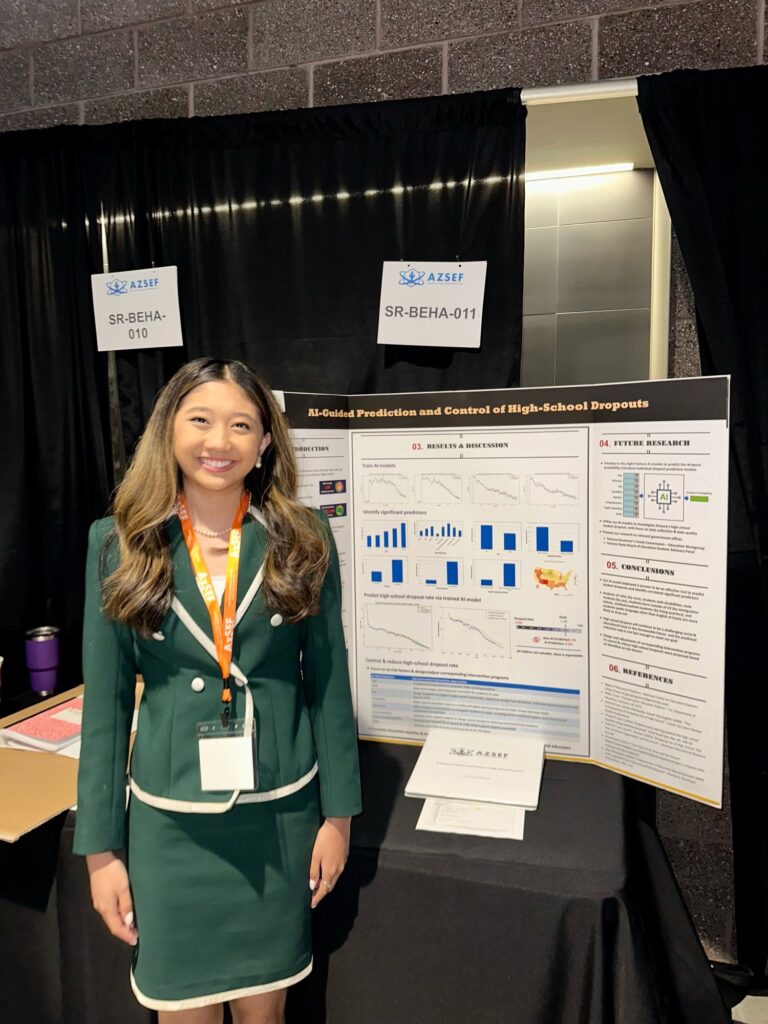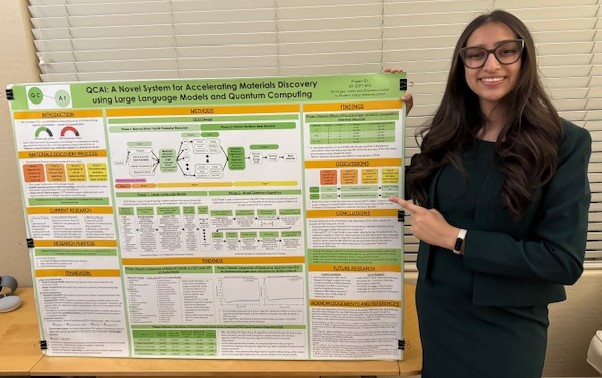Arizona high school students advance promising scientific research through ASU internship program
The world as we know it follows certain scientific rules that make sense to us almost from the day we’re born. Like if you push a toy car, it moves in the direction you pushed it.
But in the quantum world, the rules bend and blur. Sometimes, a tiny particle can occupy more than one space at the same time, or it can act like a wave instead of a solid object. It’s like playing with a toy that can be in two places at once.
Yet, researchers are still scratching the surface of possibilities—possibilities with vast implications for the next 20, 50, and even 100 years. Because quantum information science and technology have a long-term, multigenerational trajectory, it’s essential to educate students early to spark their curiosity and provide them with opportunities to see how quantum can positively change the world.
That’s why Houlong Zhuang, with the Quantum Mechanical Engineering Laboratory at Arizona State University, mentors graduate, undergraduate, and exceptional high school students in quantum engineering.
Sparking a passion for quantum in high school
Since 1998, more than 1,000 Arizona high school students have participated in SCENE—ASU’s Science and Engineering Experience. The program provides 10-12th grade students an opportunity to learn how to conduct real science experiments. Students design and conduct an original research project while working alongside a university professor. Participants work in state-of-the-art labs at ASU to answer their original research questions and then compete in regional and national science competitions.
This year, Zhuang mentored three Arizona high school students: Harshil Avlani, a senior at BASIS Chandler; Sophia Lin, a junior at BASIS Scottsdale; and Prisha Shroff, a junior at Hamilton High School. Together, they delved into the world of quantum computing and its applications in solving some of society’s most pressing challenges, such as preventing forest fires and deep fakes.

The students work on designing and implementing quantum algorithms, analyzing practical applications, and experimenting with quantum hardware. Under Zhuang’s guidance, they gain valuable skills and a deep understanding of theoretical concepts through hands-on experience, setting the stage for future innovations.
“These high school students are doing incredible work in quantum computing and AI,” said. Zhuang. “It is immensely rewarding to see them tackle tough concepts and contribute to the future of technology. Their curiosity and innovation show just how much young minds can push the boundaries of what’s possible in science and technology.”

Mitigating misinformation with a new quantum architecture: Harshil Avlani
During the COVID-19 pandemic, Avlani began exploring quantum computing while taking online classes. When he entered his “Analyzing the Effect of Mid-Circuit Measurement on Spectator Qubits” research about errors in quantum computers into the Arizona State Science Fair, he took first place, qualifying him to compete in the International Science Fair. There, Avlani won first place in the System Software category.
Fresh off a winning streak, he entered the Science Talent Search program – a massive fair for the most promising young scientists. Just by being accepted, he was awarded a $25,000 academic scholarship.
But beyond the scholarship, the most valuable outcome from all of the competitions for Avlani was learning about Zhuang from one of the judges for his AZSEF quantum computing project. When Avlani was accepted into ASU’s internship program, his first choice for a mentor was Zhuang.
“He’s teaching me about quantum machine learning and helping me figure out potential projects within quantum machine learning itself,” shares Avlani. “We’ve worked on transformer architecture, and now we’re working on the GAN architecture, which can generate images that look real but aren’t. You see a face that looks so realistic, but it’s not. It’s fake.”
These images can be used for artistic purposes, such as realistic digital art, or for practical purposes, such as generating images for machine learning models. However, this technology could also be used to create fake news or misinformation, which could have serious consequences. Avlani realizes it’s important to consider the ethical implications of this technology and use it responsibly.
Advancing policy research through quantum technology: Sophia Lin
As long as she can remember, Lin has been passionate about equity in education and curious about the policies surrounding it. Having learned about quantum computing and generative AI, she considered their vast potential to guide the future of education with lightning-fast predictive analytics.
Quantum computers are very good at processing large amounts of data because they can perform multiple calculations simultaneously. This makes them excellent for AI tasks that need a lot of data processing, like Lin’s research. Under Zhuang’s mentorship, she developed an AI model, enhanced by quantum computing approaches, to analyze education dropout rates, identify areas of disparity, and inform more inclusive policies and support structures for students.
“We used our AI model to identify the specific factors that contribute to dropout rates and forecasted ten years into the future,” Lin said. “This allowed us to better understand the issues at hand and find ways to combat these disparities to ensure that the dropout rate decreases at the fastest rate possible.”

Lin entered her “AI-Guided Prediction Control of High School Dropouts” research into the Arizona State Science Fair and was awarded second place in the Behavioral and Social Sciences category. Earning recognition in the top tier at AZSEF was exciting, and observing the other students’ work provided her with more inspiration. “I saw how much our youth is engaged in science and technology and how it will shape our future,” Lin said.
With AZSEF behind her, she plans to expand on her research using quantum computing approaches to enable more flexibility for adding new, more specific variables – such as age, sex, and ethnicity – and predict their rates of dropping out to recommend better support systems that improve their chances of success in college.
“Working with Professor Zhuang gave me a multifaceted perspective and helped me understand how technology can be applied to some of our most pressing issues,” she said.
Cultivating a cleaner environment with quantum computing: Prisha Shroff
When Shroff’s family encountered a massive wildfire while traveling in California in 2020, the crisis inspired her to explore how to predict and prevent wildfires from happening. Just a couple of years later, her innovative AI-based system can pinpoint wildfire-prone areas using real-time environmental data, such as temperature, precipitation, soil moisture and wind.
Shroff’s project, “AI-based Wildfire Prevention, Detection and Suppression System,” earned special recognition from NASA at the AZSEF, and she was awarded second place in the Systems Software Category. However, during this process, she realized she needed a better way to process vast data. She later learned about quantum computing at the SciTech: STEM and Innovation Summit.

To explore opportunities in quantum computing, Shroff joined the ASU internship program. With Zhuang’s support, she developed an approach for using quantum computers to accelerate the materials discovery process.
Using both large language models and quantum computing as a framework, she is able to discover which material can best solve a problem. “It can narrow down all the information from across the web and identify a material to solve a problem,” said Shroff. “It’s kind of like a Materials ChatGPT.”
Shroff used the quantum computer and algorithm she developed to find the best material for absorbing CO2 from the atmosphere. The large language model analyzed specific material criteria in response to prompts like “What is the best material for absorbing carbon dioxide from the atmosphere?”
Next, she paired the language model with her quantum computer and algorithm to perform molecular simulations. Through this process, Shroff identified the best material for CO2 absorption.
The outcome of her work has the potential to contribute to a cleaner and healthier environment for all. Prisha’s passion for leveraging technology to solve real-world problems reflects what she considers a growing sense of accountability shared by her generation, especially around climate change.

